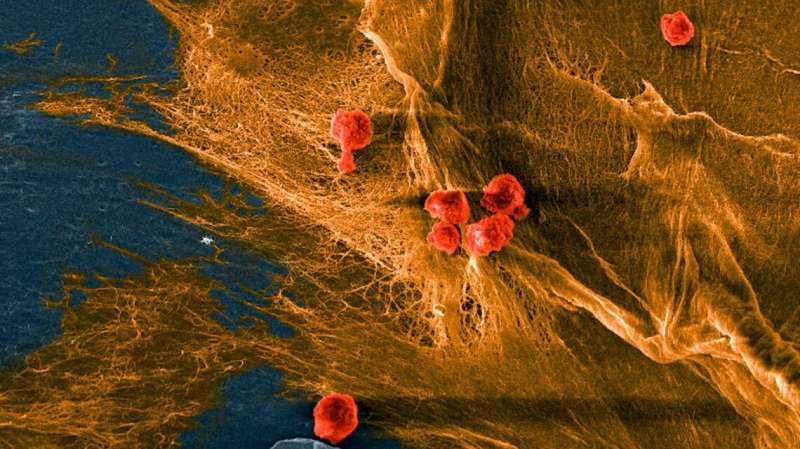Soft but tough: Biohybrid material performs like cartilage

Producing biomaterials that match the performance of cartilage and tendons has been an elusive goal for scientists, but a new material created at Cornell demonstrates a promising new approach to mimicking natural tissue.
The results were published July 8 in the Proceedings of the National Academy of Sciences, and provide a new strategy for synthesizing clinical solutions for damaged tissue.
Tissue has to be soft enough to bend and flex, but durable enough to withstand prolonged loading—for example, the weight a knee tendon must support. When tissue wears out or is damaged, collagen hydrogels and synthetic materials have the potential to serve as replacements, but neither alone possesses the right combination of biological and mechanical properties of natural tissue.
Now, Cornell researchers have engineered a biohybrid composite material with the essential characteristics of a natural tissue. The material consists of two main ingredients: collagen—which gives the material its softness and biocompatibility—and a synthetic zwitterionic hydrogel, which contains positively and negatively charged molecular groups.
"These charge groups interact with the negatively and positively charged groups in the collagen, and this interaction is what enables the materials to dissipate energy and achieve high levels of toughness," said Lawrence Bonassar, the Daljit S. and Elaine Sarkaria Professor in Biomedical Engineering in the College of Engineering and co-lead author of the study.
The biohybrid composite approaches the performance of articular cartilage and other biological tissues, possessing 40% more elasticity and 11 times the fracture energy—a measure of durability—of the zwitterionic material by itself.
Nikolaos Bouklas, assistant professor in the Sibley School of Mechanical and Aerospace Engineering and co-lead author of the study, said the material's biocompatibility means it can recruit cells and keep them alive.
"Ultimately, we want to create something for regenerative medicine purposes, such as a piece of scaffold that can withstand some initial loads until the tissue fully regenerates," Bouklas said. "With this material, you could 3D print a porous scaffold with cells that could eventually create the actual tissue around the scaffold."
In addition, the biohybrid material is self-assembling once the two ingredients are mixed, Bouklas said, creating "the same interconnected network of collagen seen in natural cartilage, which otherwise would be extremely hard to produce."
The research brought together four research labs from three different departments. The collagen used in the biohybrid composite had already been under development in Bonassar's lab, while the zwitterionic hydrogel was developed by the study's co-authors Robert Shepherd, associate professor in the Sibley School, and Emmanuel Giannelis, the Walter R. Read Professor of Engineering in the Department of Materials Science and Engineering.
The study's authors are continuing to research the material and the molecular processes behind its synthesis. Bonassar said the material is well suited for the type of bioprinting pioneered in his lab, and the authors have begun experimenting with using it as a 3D-printing material.
More information: Cameron Darkes-Burkey et al, Simple synthesis of soft, tough, and cytocompatible biohybrid composites, Proceedings of the National Academy of Sciences (2022).
Journal information: Proceedings of the National Academy of Sciences
Provided by Cornell University
















